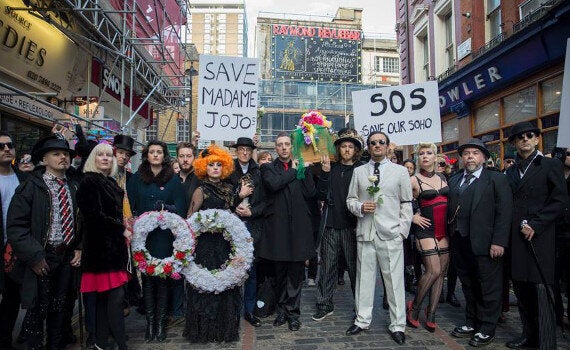London, this ancient city of ours, has two beating hearts. One, known as the Square Mile, keeps our metropolis firmly upon the world map, but so too does the other and no less vital. A mere two short syllables tell of its character that is known the world over: Soho, at once both a hunting cry of old and a word connoting a modern bohemian oasis.

Bounded by Charing Cross Road to the east, Oxford Street to the north, Regents Street at its western flank and by Shaftesbury Avenue to its south which separates it from Chinatown, Soho is a scant square quarter mile that after many centuries has evolved a geographic character of unique cultural significance.
But changes are afoot which are serving to dilute the very ethos upon which the quarter's reputation is based. Soho, with its old melting pot of artisans, artists and writers - and those who would facilitate the bringing together of all three - has always affirmed what a city should be; a hive of creativity and industry rooted in a tight-knit cosmopolitan community. From the Huguenots to the Maltese, it was ever thus.
But with steep hikes in rents in recent years, smaller businesses who have stayed the course are being forced to close. The recent announcement that famed Brewer Street club Madame JoJo's is to shut its doors permanently has caused consternation among those who wish to see Soho preserve its history. But this turn of events should come as no surprise. With the closing of The Wag, the Limelight, the Astoria and The Colony Room over the years, Soho has by stealth been transformed into an area where gastronomy of a chain variety has been supplanting independent restaurateurs and traders.
Such is the march of time. It's the natural order of commerce, but it serves to exclude those who provide the area's lifeblood, namely its artists, for without them and the picture framers, the tailors, the struggling actors and musicians, it will arguably become just another patch of nondescript West End streets.
Vice is disappearing from Soho but that, comparatively, is of little consequence for if Soho loses its artistic community, it will lose its soul. The old community once counted among its number Mozart, Percy Bysshe Shelley, Oscar Wilde, Joseph Conrad, Karl Marx, George Orwell, Dylan Thomas, Agatha Christie, Noel Coward, Lucien Freud, Jeffrey Bernard and Francis Bacon while Soho-born poet, painter and visionary William Blake came into the world in a house on Marshall Street.
This quarter of central London, therefore, has been an area where genius has flourished. Today, residents of the likes of Mark Powell and Tim Arnold do their utmost to keep the flame of art and invention alive in conjunction with the annual Soho Literary Festival, Berwick Street Market, the art collective Vermilion Hook, admirable literary hub The Society Club on Ingestre Place and even the modern incarnations of Ronnie Scott's jazz club and the Soho Theatre.
The Soho Hobo's (aka Tim Arnold, pictured above in white) recent letter to the mayor of London urged greater protection for the area and has garnered support from Benedict Cumberbatch, Roger Daltrey, Pete Townshend and Eddie Izzard among others. Thus, it would appear, that Soho is about the personal experience, lending to London a not inconsiderable aspect of its own character. Soho's existence helps form the very reason why people the world over come here to work, rest and play.
As a home for diasporas seeking a freer life, its old-fashioned charm is now in need of updating by fresh, sympathetic blood. But it's a charm that must not be swept aside lest we lose something fundamental from our London commonwealth.
It's Soho as microcosm that we cherish. A nod to the very best that its people can offer when they work cheek by jowl as artisans, artists and small business men and women. But if change it must, then may it not be to the detriment of its cultural fabric. It has always been a place of energy and never a backwater. It's Soho as paradigm, the jewel of immigrant toil, a flavoursome agglomeration of alleys and streets.
But change does comes. The Crossrail development has irrevocably transformed the area's northern edge, old buildings torn down so that new ones can be built, and with Denmark Street's mooted demolition not far off, art will slowly vanish from the Soho canvas. Soho, should we need reminding, stands today as evidence of what can be achieved through metropolitan unity.
"To live is the rarest thing in the world. Most people exist, that's all," wrote Oscar Wilde, and so if Soho is to lose the very people and businesses that have made it the cultural mecca it has long been, it is time to remember, yes, but it is also a time to help save the area from an obliterative, commercialised fate. Somehow.
Photograph by Juliet Shalam
